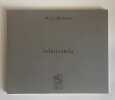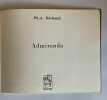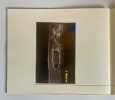MICHAUD (Philippe-Alain).
Admiranda.
Paris, Éditions du rouleau libre, 1990. Petit in-4 oblong, en feuilles.Édition originale illustrée de peintures à la gouache de Jean Ferdinand sur 7 chronophotographies contrecollées d'Étienne-Jules Marey.Tirage à 39 exemplaires, n° 22.Les Éditions du rouleau libre ont été créées en 1975 par le poète et éditeur Jean-Paul Louis (Éditions du Lérot), avec l’idée d’un espace libre pour la poésie contemporaine, des textes marginaux ou “hors norme”, et une liberté formelle, concevant le livre comme un objet d'art. Proches de certaines revues militantes et poétiques (comme Action poétique, Le Dé bleu ou Le Temps des cerises), les Éditions du rouleau libre ont accueilli des poètes confirmés (André Laude, Jean-Pierre Verheggen, Philippe Jaccottet…), mais aussi des voix nouvelles. Il en fut de même pour les collaborations artistiques (Henri Michaux, Pierre Alechinsky , Jean Cortot, Joaquin Ferrer, Antonio Saura…).
Reference : 1178
Bookseller's contact details
Ségolène Beauchamp
Mme Ségolène Beauchamp
segolene@beauchamplivresanciens.com
06 64 67 12 60
Payment mode
Sale conditions
Conditions de vente conformes aux usages de la profession. Les prix sont nets, en Euros, port en sus. Emballage gratuit.
5 book(s) with the same title
Diva Virgo Hallensis. Beneficia eius & Miracula fide atque ordine descripta [1] Diva Sichemiensis sive Aspricollis : nova eius Beneficia & Admiranda. [2] Collection of 2 works in one volume.
[1] Antwerpen, ex officina Plantiniana, apud Viduam & Filios Io. Moreti. 1616, in-4°, 25 x 18 cm, (8) nn pp + 86 + (10) nn pp (complete). Title with engraved vignet. penultimate page with wood-engraved printer's mark. [2] Antwerpen, ex officina Plantiniana, apud Balthasarum & Viduam Ioannis Moreti, & Io. Meursium. 1620, in-4°, (8)nn pp + 69 pp + (11)nn pp ,Title with engraved vignet. penultimate page with wood-engraved printer's mark. Title page of the first work with contemporary manuscript ex-libris of the Jesuits of Brussels and with a modern small circular stamp. Bound in contemporary full vellum ( vellum soiled and with some scratches), title of first book also a bit soiled and thumbed, Two later editions of Lipsius' popular narrative of the miracles of the Holy Virgin at Halle (BCNI 6287) and Scherpenheuvel (BCNI 6784). The great humanist returned to the Roman Catholic belief, leaving the protestant North, and now devoting his time and art to the spread of the news of the miracles of the Holy Virgin in his beloved Brabant. As a real Fleming he finally went back to his ancestral hearth.
Admiranda, sive, de Magnitudine Romana libri quattuor. Tertia editio correctior, auctiorque.
Antverpiae apud Joannem Moretum 1605 In-4 de 223-(1) pp. et 4 ff. n.ch. (le dernier blanc), vélin souple, large mouillure angulaire sur l'ensemble du volume. (Reliure de l'époque).
Dernière édition publiée du vivant de l'auteur (E.O. à Anvers, 1598). Elle est imprimée par Jean Moret, gendre et successeur de Plantin, et ami personnel de Juste Lipse. "Il n'est presque pas de problème en rapport avec les antiquités romaines sur lequel sa critique n'ait jeté une clarté durable…" (Hoefer). Bon exemplaire intègre, malgré la mouillure. Ex-libris manuscrits anciens sur la première garde et la page de titre.
Collection of 4 works in one volume. [1] De Cruce Libri Tres. Editio quarta. [2] Diva Virgo Hallensis. [3] Diva Sichemiensis sive Aspricollis : nova eius Beneficia & Admiranda. [4] Lovanium: id est opidi et Academiae eius descriptio. Libri Tres.
" [1] Antwerpen, ex officina Plantiniana, apud Ioannem Moretum, 1599, in-4°, 24,5 x 16,5 cm, 96 pp + (8) nn pp , with 19 etchings in the text. Imhof L-20. [2] Antwerpen, ex officina Plantiniana, apud Ioannem Moretum, 1605, in-4°, (8)nn pp + 86 pp + (10)nn pp , with 2 engraving outside the text ( of which a view of Halle) and title vignet. This is the second in-4° edition. Imhof L-37. [3] Antwerpen, ex officina Plantiniana, apud Ioannem Moretum, 1605, in-4°, (8)nn pp + 69 pp + (11)nn pp, title with Virgin and child engraving (T.Galle). Second in-4° engraving. Imhof L-34. [4] Antwerpen, ex officina Plantiniana, apud Ioannem Moretum, 1610, in-4°, (8)nn pp + 121 pp + (7)nn pp, with 2 plates (folding view of Louvain, idem of Heverlee) and an in-text plate. Imhof L-54. Bound in somewhat later full calf, raised gilt spine with decoration and red leather title label, marbled end papers, triple gilt fillets on both coversmarbled edges. Finde binding with minimal traces of use. Ome of the pages are uniformly but slightly browned ( more so for the first title). Title page of the 3rd work with a faint waterstain. The folding plates in the 4th work with some false creases. Generally the 4 titles are in good condition. The binding is very finely preserved. There are no provenance indications. Fine collection of 4 works by Lipsius. Apart from the 1st work which was already published in 1593 and which deals with mostly classical history ; the 3 other titles date from the end of Lipsius' career and pertain to the near local history of the region of his birth.."
Thaumatographia naturalis in decem classes distincta in quibus admiranda
Amsterdam, Guilhelm Blaev, 1632, in-12, [4] ff, 5 à 501 pp, Vélin de l'époque, dos lisse titre à l'encre. qq rouss, f. A4 dentelé. ex-libris manuscrit, I - Coeli, II - Elementorum, III - Meteororum, IV - Fossilium, V - Plantarum, VI - Alium, VII - Quadrupedum, VIII - Exanguium, IX - Piscium, X - Homini. Première édition. La Thaumatographia Naturalis (ou description des merveilles de la nature) a paru pour la première fois en 1632. Outre l'aspect scientifique on trouve dans ce recueil sur les animaux, les plantes, les météores, les fossiles, les oiseaux, etc, nombre d'anecdotes curieuses et étranges. Johnston rapporte plusieurs cas de somnambulisme. Ainsi un jeune homme sortait toutes les nuits de son lit, vêtu seulement de sa chemise ; puis montant sur la fenêtre de sa chambre, il sautait à cheval sur le mur et le talonnait pour accélérer la course qu'il croyait faire. Un autre descendit dans un puits et s'éveilla aussitôt que son pied eut touché l'eau froide. On trouve collecté dans l'ouvrage nombre de superstitions et croyances anciennes sur les propriétés des plantes. Provenance : Philibert-Joseph Le Roux, (auteur du Dictionnaire comique, satyrique, critique, burlesque, libre et proverbial, 1752) avec sa signature sur le page de titre. Incomplet des 4 premières pages matérialisées par des ff. bl. Garrison-Morton 287" A compilation of all the contemporary zoological knowledge". DSB VII, p. 164 "the significant contribution his works made to the growing interest in natural history during the first half of the seventeenth century." Couverture rigide
Bon [4] ff., 5 à 501 pp.
Danica historia libris XVI, annis ab hinc trecentis qvinqvaginta summa verborum elegantia, magna sententiarum grauitate, rerum denique admiranda varietate, intermixtis aliarum quoque Gentium historijs, conscripta. [Bound with:] Germanicarum Rerum Quat... - [THIRD AND LAST 16TH CENTURY LATIN EDITION]
Frankfurt am Main, And. Wechel, 1576. Folio. Bound in contemporary blindstamped pigskin over wooden boards with the two original brass clasps. Hinges with grey coloured repair. Lower part of spine with traces after having been coloured red and blue. A very fine and clean copy. [Saxo:] (8), 342, (24) pp + 1 blank leaf + [Germanicarum Rerum Quatuor... :] (10), 224, (10) ff.].
Third and last 16th century Latin edition of Saxo's ""History of Denmark"", edited by Philip Loncier, rector of the Frankfurt Gymnasium.Saxo Grammaticus (ab. 1150-1220) was probably a secular clerk or secretary to Absalon, Archbishop of Lund, the great Danish churchman, statesman and warrior. Saxo is remembered today as the author of the first full history of Denmark, in which he modeled himself on the classical authors (e.g. Virgil, Plato, Cicero) in order to glorify his fatherland. The work dates from the end of the 12th century and was edited by Christiern Pedersen, a Canon of Lund, and printed by Jodocus Badius Ascendius in Paris in 1514 (the editio princeps) with 16th century re-issues following in 1534 (Basel) and 1576 (the present). Only with the first printing of this seminal work did the work become known throughout academic circles. The work soon received international fame and is to this day renowned as not only being immensely important historically, but also being extremely well written (Saxo is praised by Erasmus, for instance, for possessing great power of eloquence). The work consists of sixteen books that cover the time from the founders of the Danish people (Dan I of Denmark) till Saxo's own time, ending around 1185 (with the submission of Pomerania), when the last part is supposedly written. The work thus covers the entire history of Denmark until Saxo's own time, seen under a somewhat glorified perspective, from heathen times with tales of Odin and the gods of Valhalla to the times of Absalon, who probably directly influenced the sections on the history of his own time, working closely with Saxo himself. Apart from that, the work contains the first known written narration of the legend of Hamlet (Amleth, the son who took revenge for his murdered father). It is most likely this narrative of Saxo's, which he based on an oral tale, that forms the basis for Shakespeare's ""Hamlet"", which takes place in Helsinore in Denmark. There is fairly certain evidence that Shakespeare knew Saxo's work on the History of Denmark and thus, from that, the legend of Amleth.The editio princeps was printed in Paris in 1514, the second edition being printed in Basel in 1534.LN 1450Thesaurus 190.GERMANICARUM RERUM QUATUOR...Bound with Saxo is German Simon Schard's (1535-1573), History of Germany from the time Augustus till Henry IV.Adams G 488
 Write to the booksellers
Write to the booksellers







